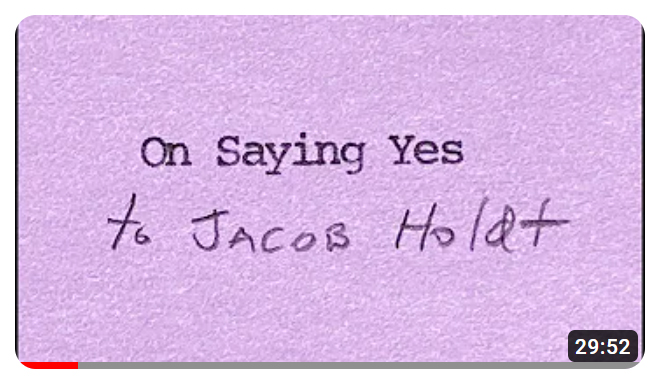Transcription
from Alec Soth's talk above on video:
Hey there this is Alec Soth and I’m back in
my library for another rambling photo book
talk.
This one's going to be a real rambler,
because I’m basically just kind of working
through some evolving thoughts on a
particular photo book. So, either bear with
me or jump ship.
I understand as well if I were listening to
this. So, we'll see what happens.
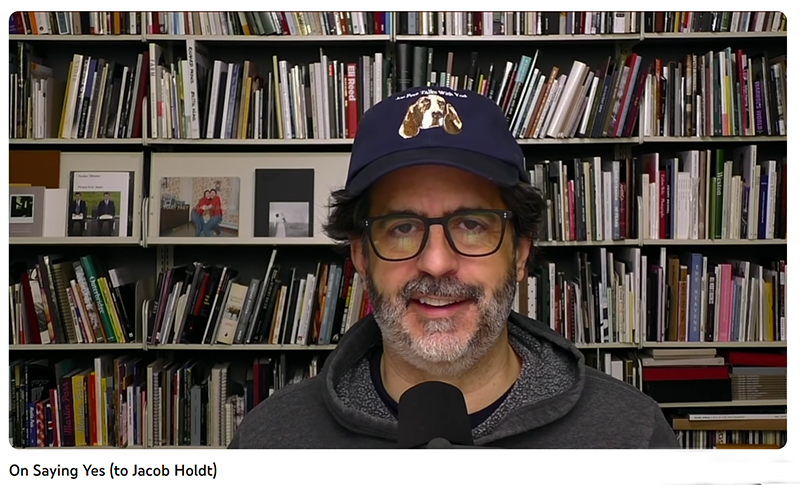
The book that I want to talk about is
American Pictures by Jacob Holdt. And this
book is one that I’ve encountered in used
bookstores for as long as I’ve been a
photographer and I always avoided it. I
might crack it open for a second and then I
would put it back on the shelf.
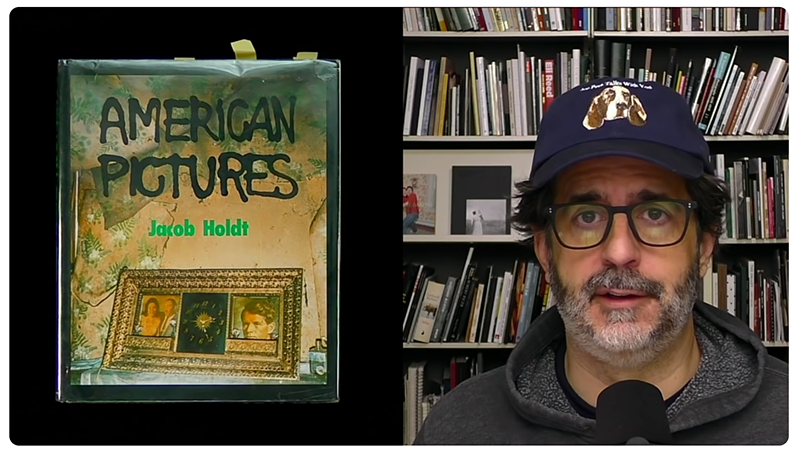
The reason, I think, there are multiple
things. For one you know this typography, I
hated the title, I hated the look of this,
and then you open up the book and it's tiny
pictures for the most part, tons of words
and I just wasn't interested and didn't
think that much about it.
And then in 2007 Steidl came out with this
book called
“Jacob Holdt - United States
1970-1975”.
And this I thought was going to be a moment
for me to reevaluate American Pictures and I
think it was around that time that I
actually bought this copy of American
Pictures to accompany it. But the truth is I
still didn't read American Pictures. I still
had a bias against it and to be perfectly
honest I wasn't in love with the Steidl
version either. It had this cover picture
that looks sort of like a Winogrand, really
nice picture, and it's a well printed book
and it has the kind of classic design that I
often respond to. So, I thought this is
promising and - I’ll just take you through
the beginning of the book - and I
think this sort of represents my experience
with it.
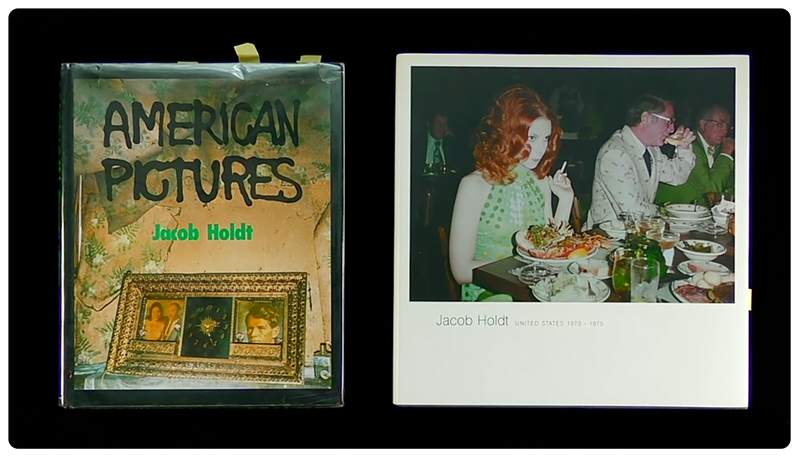
Okay it starts with this, you know, somewhat
Eggleston-like picture in the south and then
an interior photograph - both of these are
strong photographs. But here begins the
issue where I have knowledge that this is a
white European man photographing largely
black people in the south.
Again, all strong pictures, but there was
something about the kind of racial politics
that made me uncomfortable and I kind of
just gave up on the book.
I didn't really give it much more attention
and I did not read the essay in the back
here by a guy named Christoph Ribbat and he
actually in that essay which I recently read
pretty much sums up what my problem was.
He writes, “Holdt’s story looks like a,
well, difficult case in contemporary art. To
summarize briefly: here’s this white,
Northern European man, free, independent,
equipped with all the middle-class
privileges. Driven by exhilaration and
moralistic excitement, he sets out to shoot
a couple of thousand pictures of the life
and suffering of black America. ………This
already constitutes a problem in many
ways……And doesn’t Holdt exoticize the black
body here? It could almost be read as a
fetish, the views of nudity indications of
primitivism, and the photographic act as a
re-humiliation of those already humiliated
by poverty.”
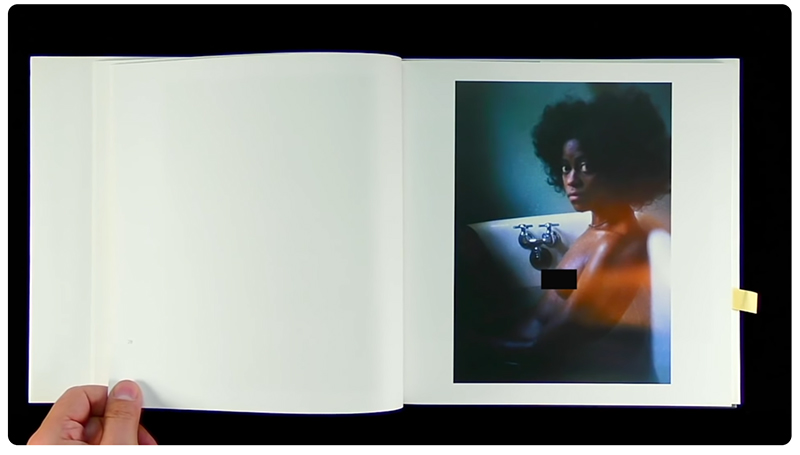
And there is a fair amount of nudity and of
black women in particular. And so, the book,
I just thought, no it doesn't work for me.
It's nicely produced, nice photographs in
it, but it makes me queasy, and I put it
back on the shelf.
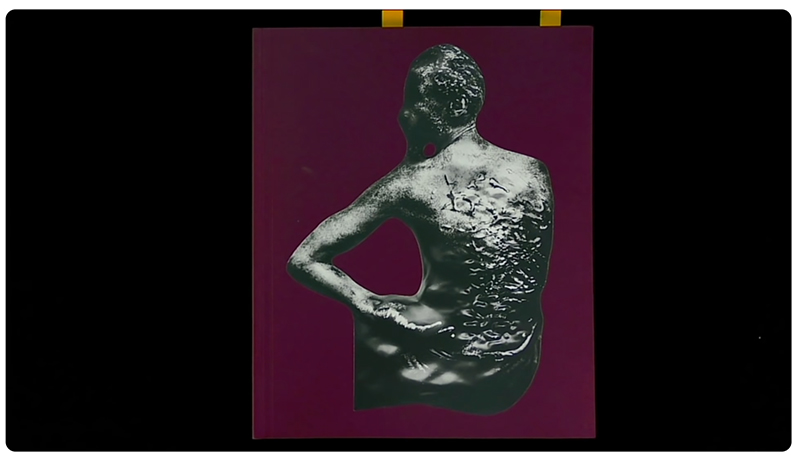
Then in the last month I acquired this book
“Magnum” by Arthur Jafa and Arthur Jafa is
primarily known as a video artist also works
as a cinematographer and makes other kind of
art as well, but he's best known for his
videos. And I was interested in this book in
particular because I knew that it was going
to have examples of Arthur Jafa's clippings
basically. For his entire life - I think
since he was a child - he had been clipping
out photographs and putting them into books
- not as an art form, but just as a consumer
of images. And so back here in this section
of the book we see “Spreads from book 27”.
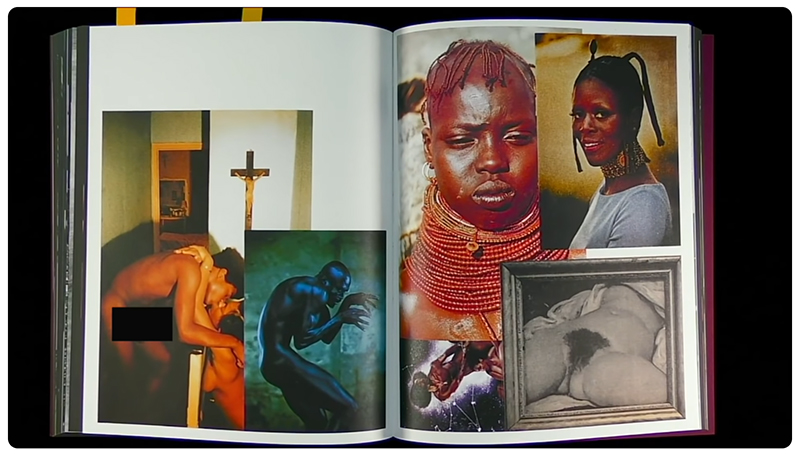
And so here on the first spread is in fact a
picture by Jacob Holdt right here and we go
on and then here's a picture by the
photographer Birney Imes. I’ll talk about in
a second. And just a random assortment of
pictures that were attractive to Arthur Jafa
for his process.

Okay so, I saw that and then I very quickly
noticed that Arthur Jafa has a conversation
with Jacob Holdt in the book.
So, this was surprising to me. You know,
again I had this kind of bias against Jacob
Holdt and I’m like, wow Arthur Jafa, he's
got a Jacob Holdt picture in the book, and
now an interview. He must really like this
guy and in fact Jafa is this enormous fan of
American Pictures.
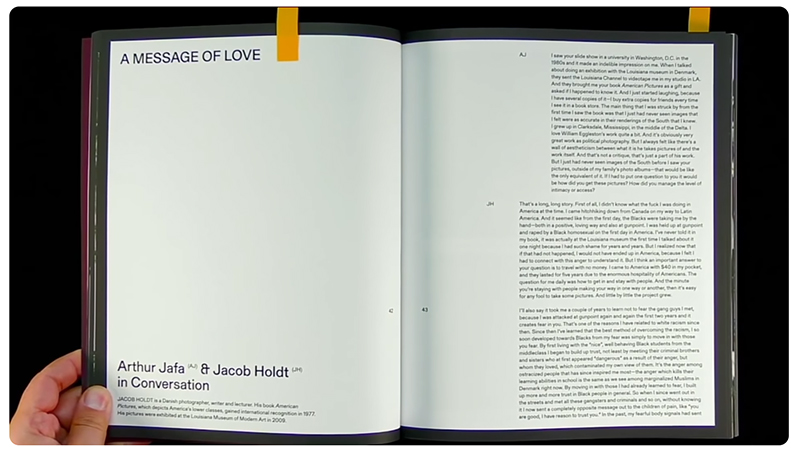
And so, I’m going to do a fair amount of
reading now, so, bear over with me. But in
this interview which is really Jafa
interviewing Holdt which is kind of
interesting - I mean we're looking at a
retrospective book of Jafa's work and he
decides to interview Holdt - and he writes
at the beginning “I saw your slideshow in a
university in Washington D.C.in the 1980s
and it made an indelible impression on me.”
Okay so this brings up something else that I
want to mention right from the get-go. So,
this book, American Pictures, was this
enormous success and I think it was
something like twenty thousand copies sold
out in two weeks or something, right after
it was published. But Jacob Holdt was
extremely concerned about the success of the
book and in fact didn't publish it in the
U.S. for many years and had all sorts of
problems with it. But what he wanted to do
was really to inform people and he wanted to
be an educator, he didn't want to make art.
And so, what he did was, he created a
slideshow that he took to universities so he
could talk about the work in context. And he
traveled in the university circuit for many
years and with huge audiences. And so,
Arthur Jafa was a first exposed to this work
in that context which I think is important.
Would Jafa had responded to this book on its
own without having seen the slideshow? He
very well might have, but I think that's
important. Okay so he says he sees that
slideshow and then he mentions that he was
having this exhibition at the Louisiana
museum in Denmark. And they sent him a copy
of American Pictures and he kind of laughed
because he says like “I’ve been buying
copies of this book for years to give to
friends”, and he writes:
“The main thing that I was struck by from
the first time I saw the book was that I had
never seen images that I felt were as
accurate in their renderings of the South
that I knew. I grew up I grew up in
Clarksdale, Mississippi, in the middle of
the delta. I love William Eggleston's work
quite a bit, but I always felt like there’s
a wall of aestheticism between what he takes
pictures of and the work itself.”
So, then Jafa kind of begins the interview
and says, “How did you make these pictures?”
So Jacob Holdt has spent decades telling the
story of how he hitchhiked across America,
but he adds something very important here
and he says, “Well that's a long story.
First of all, I didn't know what the fuck I
was doing in America at the time. I came
hitchhiking down the from Canada on my way
to Latin America. And it seemed like from
the first day, the blacks were taking me by
the hand - both in a positive, loving way
and also at gunpoint. I was held up at
gunpoint and raped by a black homosexual on
the first day in America. I’ve never told it
in my book, it was actually at the Louisiana
museum the first time I talked about it one
night because I had such shame for years and
years. But I realized now that if that had
not happened, I would not have ended up in
America, because I felt I had to connect
with this anger to understand it.”
Okay that is an incredible revelation and
it's a window into Holdt's personality and
his approach - not just to photography, but
to life. So that kind of honesty right there
led me to read the text in Holdt's book and
it is simply remarkable and kind of
breathtaking.
There are all sorts of problems with this
book. It's just, like I said from a design
perspective, it's really hard to read,
there's too much text on the page, the
pictures are too small, there are too many
pictures and frankly it needs editing.
Somewhere in here, I think in the back of
the book, because this is an updated version
of it. Holdt talks about first publishing
the book and I think he wrote it in two
weeks. It was just like a stream of
consciousness writing, but wow, does he have
stories from his travels, and I mean, let's
see if I can find some of these little
nuggets here.
I mean, first some stuff that I highlighted
here. In his opening acknowledgments he
thanks people for the financial aid, Alice
for 10 dollars, Jack Ray for 20, Susan
Kennedy for 30. This was a real shoestring
affair.
Holdt talks about how he mostly funded his
travels with plasma donations.
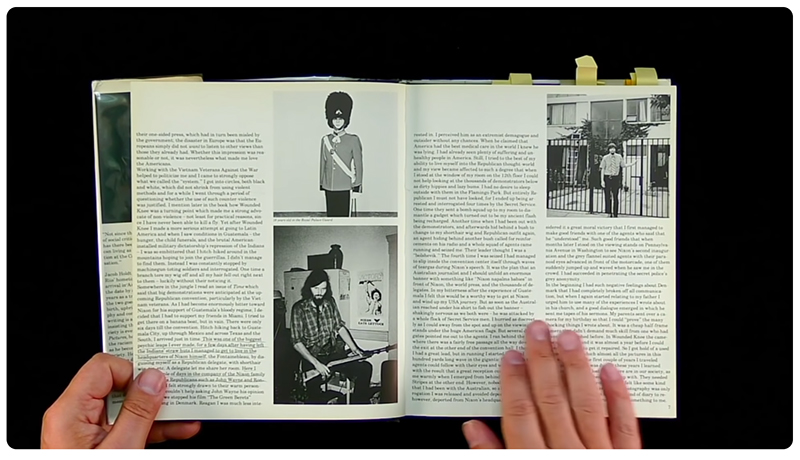
Let's see, here he talks about having been
in Mexico staying in these straw huts, and
then suddenly is going to Washington D.C.
where he wears this short hair wig (pointing
to picture in book) and ends up at the
headquarters of Nixon and meeting John Wayne
and Ronald Reagan and spending time with
them, which is pretty remarkable. Later in
the book he tells a story about driving
around with Edward Kennedy and I think Bert
Bacharach, they're totally drunk, there's
stuff he's even apprehensive about revealing
in the book. And so, he has these wild
experiences with wealthy people and then of
mostly with impoverished people. And he's so
candid all the time and there's a sexual
element to his travel. So, he writes here,
“Many of these relationships were sexual in
origin. It was often as if you had to pass
such a threshold to reach the intimacy that
lets you open up to each other. Certainly,
it could be a little irritating and
exhausting with my inability to say no, when
I would get three rides with homosexuals in
a row or even worse, three religious lifts
with three different sermons.”
So, he had this philosophy of saying yes to
everyone. So he would sleep with men, he
would sleep with women. I think he slept
with a priest. He would shoot heroin sell
drugs, pray with people, hang out with the
Ku Klux Klan and try to empathize with every
single person's opinion. But his main focus
was black America and just the incredible
racism in black America. And this sounds
preachy and presumptuous, but Holdt knows
it. So here he writes, “To obtain a complete
impression of the Afro-American situation
you must do other reading. If you do not
intend to do that, blacks will be better off
if you don't touch this book. It is and can
only be a vagabond's impression and must on
no account be considered the statement of an
expert.”
Okay, so I’m just going to flip through some
pages, you know, it goes from black and
white to color. The reproductions aren't
good, lots of inferior pictures in here. But
it's true as Jafa says, “Holdt shows things
that hadn't been seen before.” He takes us
into these camps which are virtually slave
camps, and we see them in color, and we see
the brutality of these places and keeping in
mind that this is the 1970s.
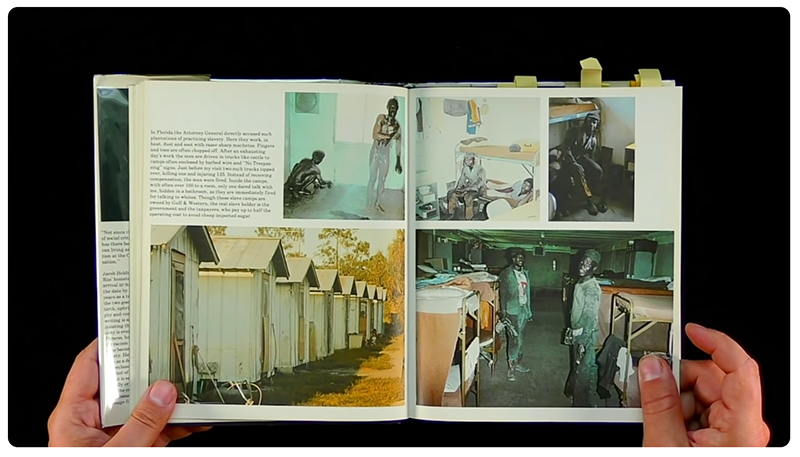
Here's another moment where Holdt talks
about the purpose of his work. He says, “The
only thing that has any meaning for me in my
journey is being together with these
lonesome and shipwrecked souls. My
photographic hobby is really when all is
said and done nothing more than an
exploitation of the suffering which will
probably never come to contribute to an
alleviation of it. But still, I can't stop
registering it, because in some way or
other, it must get out to the outside
world.”
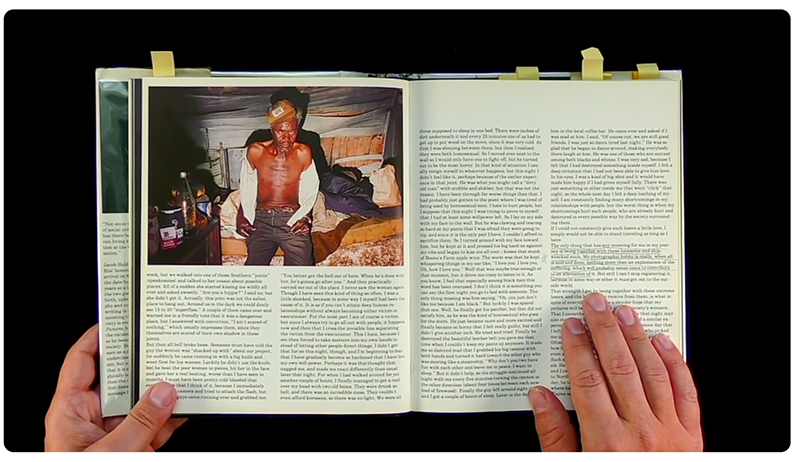
So, here's a kind of manifesto on saying yes
and his philosophy. Again, in talking about
sexuality, it's pretty remarkable to think
about this book being published, I think
this version was in 1984 or so, but showing
pictures of gay life in America and talking
in a really complex way about it.
So here he tells this story of hitchhiking
in Baltimore, and he gets picked up by this
beautiful black woman and later they start
kissing and he realizes that she's a drag
queen. And he's you know completely of
accepting of this and he writes, “To meet
these proud drag queens and transsexuals was
for me a happy surprise since they did not
live the half-life of cringing civility I
had met previously on the road. Theirs was a
genuine counterculture and is therefore
oppressed like the black subcultures.”
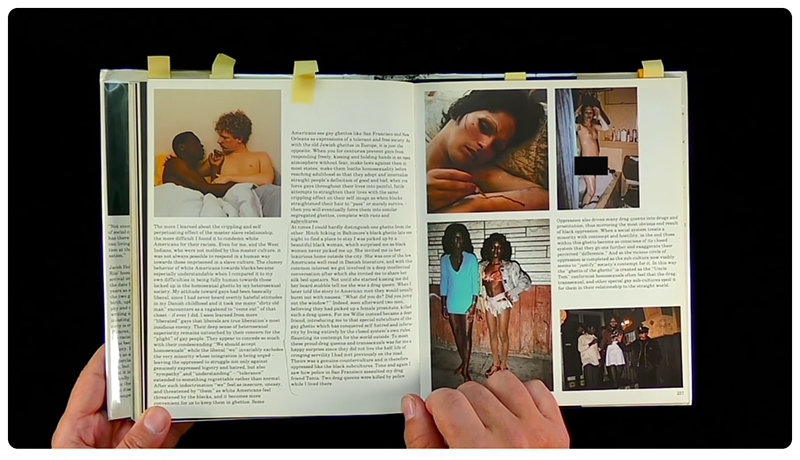
So again, this kind of openness and empathy
for everyone which makes what could seem
like exploitive pictures so much more
acceptable.
So, this chapter “James and Barbara’s love”
is so powerful and so relevant to our
current situation that I want to share a bit
of it. It starts, “One day I saw in the New
York times a picture of mayor Lindsay
presenting a bouquet of flowers to a
“heroic” police officer in a hospital bed.
It said he had been shot while “entering an
apartment”. I decided to find out what was
actually behind this incident and nosed
around the Bronx for several days to find
the relatives and the apartment where it all
took place. Little by little I found out
what had happened. James and Barbara were a
young black couple who lived in the worst
neighborhood in the USA around Fox street in
the South Bronx. One day they heard burglars
on the roof and called the police. Two
plainclothes officers arrived at the
apartment and kicked in the door without
knocking. James thought it was the burglars
who were breaking in and he shot at the door
but was then himself killed by the police.
When I went to the 41st precinct police
station they confirmed the story and
admitted that “there had been a little
mistake.” I was now so used to this kind of
American logic that I did not feel any
particular indignation toward the officer. I
just felt that he was wrong.”
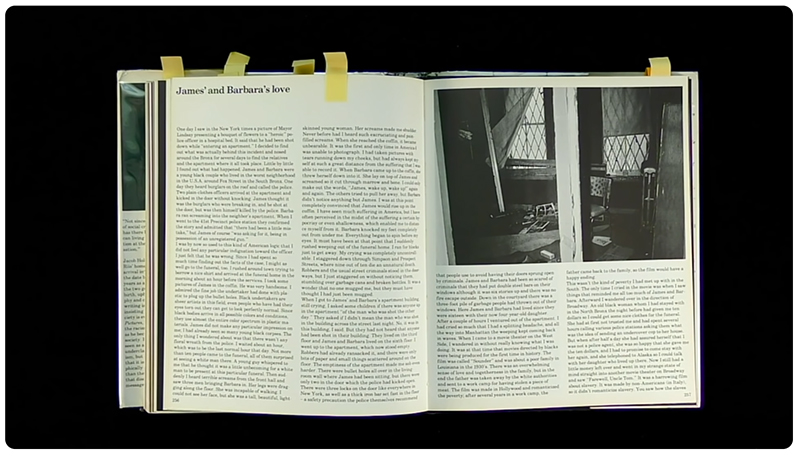
So, after this Holdt decides that he's going
to attend the funeral and he shows up there
and Barbara has a complete breakdown, she
just screams like he'd never heard before.
And this really haunts Holdt, really for the
rest of his life. So, after the funeral
Holdt decides to revisit their apartment
where this happens and learn more about the
couple. He learns that they've been together
since they were 16 and were deeply in love.
They had a four-year-old child. They also
had all these security measures in their
house, because even though they were on a
higher floor they had gates over their
windows to protect themselves. And Holdt is
just devastated by this loss and so over the
years he talks about returning to try to
find Barbara. And each time she's gone, and
he eventually learns that she's essentially
gone insane.
So, here again is that picture which Arthur
Jafa describes in his book Magnum and so I
want to go back to that book and talk a bit
more about what Jafa has to say.
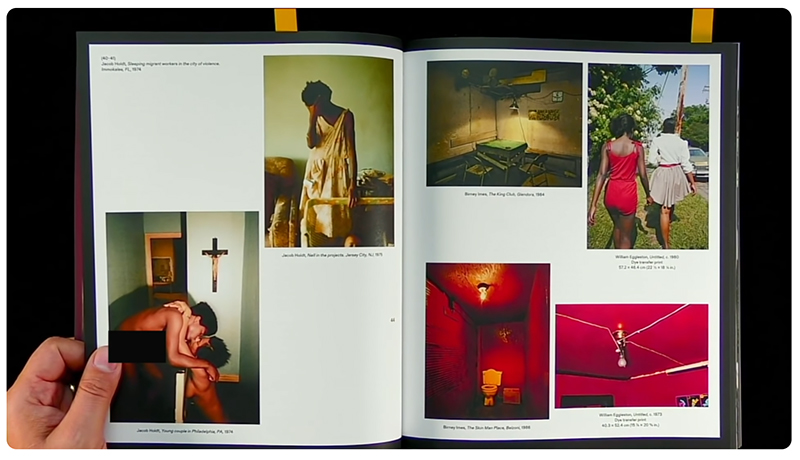
Here Jafa shows the picture again as well as
this one and also interestingly shows a
couple of Eggleston pictures and a couple of
Birney Imes’ photographs. Interestingly I
should mention that this book “Juke Joint”
by Birney Imes is a book that when I was a
young photographer I was in love with, and I
thought was absolutely fantastic. And I had
no conflict about a white person
photographing black culture just as I didn't
with Eggleston, and I think it's partly
because of that aestheticized view. Later
though, it's interesting I haven't really
looked at “Juke Joint” for a number of years
because of a different sort of political
consciousness. But then Jafa kind of
corrects me of that and is a fan of Birney
Imes. And actually, here Jafa talks about
showing “Juke Joint” to his father. He says,
“When I was in my late 30s, I asked my
father if he wanted to work with me on a
project because, as I said, he was just so
fluid in terms of meeting people. I was in a
car with him driving from Atlanta to
Mississippi when midway on the eight-hour
trip I showed him a photo book called “Juke
Joint” by Birney Imes and he quietly flipped
through the book. I asked him if he didn't
think it was amazing and he said, “I don't
see any creativity in this book whatsoever.
There's no creativity in taking pictures of
people who have nothing.”
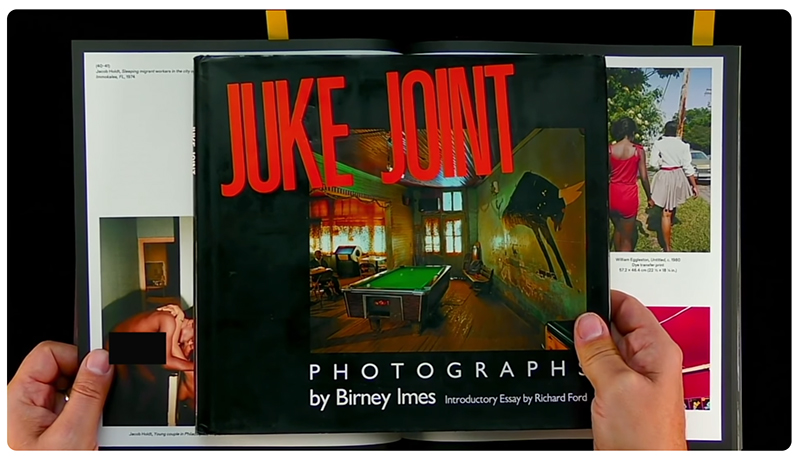
And so here Arthur Jafa talks about this
photograph (by Jacob Holdt). So, he writes,
“I’m talking about the unvarnished rendering
of black people's lives, how black people
were living, the pain, the anger, all of
that. But I also have to say, there are
images of black love and intimacy, that are
in those same pictures. There's a famous
picture that you took - or at least it's
famous in my own little Pantheon - of a
black man at the top of the stairs with
black woman, and they're nude. Nobody's ever
taken a picture of black love like that
before.” And so Holdt then goes on to talk
about his very deep relationship with that
couple and we learned time and time again
from this interview and from American
Pictures that Holdt has these really
authentic deep relationships with the people
that he photographs.
So, what is this video about? I guess it's
about encouraging more openness. I was shut
down to American Pictures, I didn't really
accept the book because it was made by a
white person. And it was only by seeing
Arthur Jafa's openness that I was able to
encounter it and thus be exposed to all of
Jacob Holdt's openness.
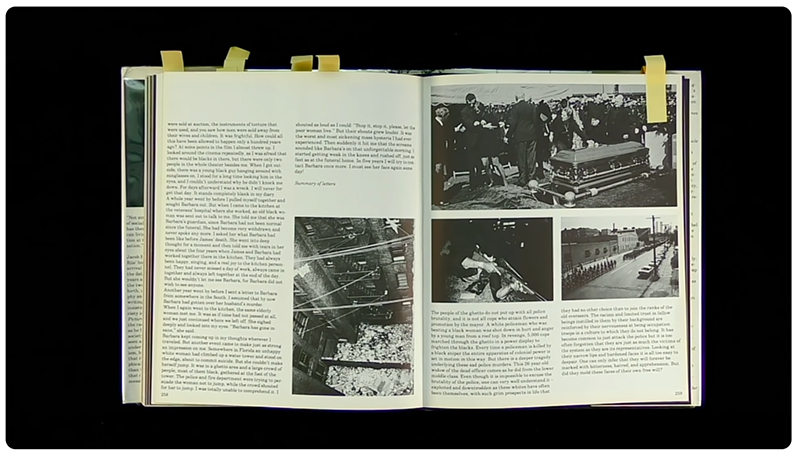
Oh man, and this reminds me of something
that I forgot to share. So let me just
quickly return to the story of James and
Barbara and at the end of it Jacob Holdt
writes this, ”Even though it is impossible
to excuse the brutality of the police, one
can very well understand it, exploited and
downtrodden as these whites have often been
themselves with such grim prospects in life
that they had no other choice than to join
the ranks of the old overseers. The racism
and limited trust in fellow beings instilled
in them by their backgrounds are reinforced
by their nervousness at being occupation
troops in a culture to which they do not
belong. It has become common to just attack
the police but is too often forgotten that
they are just as much the victims of the
system as they are its representatives.
Looking at their narrow lips and hardened
faces it is all too easy to despair. One can
only infer that they will forever be marked
with bitterness, hatred and apprehension.
But did they mold these faces of their own
free will?”
So, it's that kind of openness to thinking
about other people's perspectives that's so
valuable in Jacob Holdt’s work and it's also
an incredible part of Arthur Jafa's work.
And so, I hope you'll check out both books
and I thank you for watching this.
See you next time.
Alec Soth
Comments on YouTube:

@matthamon8421
1 year ago (edited)
Thanks again, Alec! It's so generous of you
to be putting your time and energy into
these videos. You could easily monetize this
with a Masterclass, and I'd happily pay.
But, I sincerely appreciate you offering
this to aspiring photographers. I have
written your YouTube channel into my
syllabus as a subtle (but strong) suggestion
for any student who is working on a greater
understanding of this complex medium. It's
very generous of you to put your time/energy
(again) into such an honest contemplation of
the complexities of objectification, and
exploitation in photography.
33
Reply

·
2 replies

@chopster01
1 year ago
While I love all your book videos, this to
me is the most profound and important to
date. It isn’t just about art and who can
make what kind of art, but about being more
fully human.
Thank you.
17
Reply

·
3 replies

@jamesshiffer1871
1 year ago
Thank you for bringing attention to American
Pictures, a book that has been on my shelf
for nearly 40 years, though parts of it are
difficult to look at. I bought it after
seeing Jacob Holdt present his slideshow at
my university in the mid-1980s. I always
perceived his project as primarily
political, rather than artistic. These days
we don't separate the two as much as we did
back then. For me, the text and pictures
were always inseparable, and as you
observed, the text describes the motivation
of an extraordinarily courageous, creative
and sometimes reckless journalist who did
not believe in keeping any distance between
himself and his subjects.
1
Reply

@patrickjoust3281
1 year ago
Wow, I’m so glad to see you talking about
Jacob Holdt and his book! I read it (the
entire text) a couple years ago after
encountering his work in David Campany's
excelled book The Open Road, in which, of
course, your work is featured as well. I
remember bringing Holdt's book to a photo
book meet-up and I could tell that a lot of
people were a bit queasy with American
Photos and I still feel a bit queasy with
aspects of it myself but when I read the
text I realized that there is no way to
appreciate the book without reading the text
and as difficult as some of the text/images
can be it's such an amazingly honest/earnest
account that I feel like it is a real
insight into the state of race in America.
Sometimes Holdt's characterizations and
language bothers me but I appreciate the
fact that he is not trying to portray
himself as the perfect anti-racist (and
perfectly rehearsed anti-racist) but as
someone trying to work through his own
feelings and strategize on how to improve
and understand the situation. So thank you
for including your thoughts on the book and
sharing it here. I did a search, a few years
ago, trying to find some criticism of
Holdt's book and only found a little. I
remember one thing I read was that the
pictures in the book of the various women
Holdt had relationships with felt like
trophies and that resonated with me. There's
a lot of good in the book, if you take the
time to read it, but it's certainly not
perfect. However I think it's worthwhile for
people to delve into this book anyway and I
think it's a good example of the need to
resist binary thinking (this is good, this
is bad) because if we were to dismiss this
work entirely because of its faults we would
be missing the good points. It's such a rare
thing for a white person to open themselves
up, and open themselves up to criticism,
when it comes to discussing race, poverty,
discrimination and all the dynamics relating
to those things. Holdt has taken some
amazing photos but it's his words that I've
found myself most grateful for. The fact
that his words don't feel rehearsed, even in
his most recent writings (like the interview
you shared with Arthur Jafa) is amazing to
me. Anyway, sorry for the long response. I
rarely do this (write anything on youtube)
but I was so pleased to watch your post
about this that I had to respond. Thanks!
Read more
9
Reply

·
1 reply

@toddfisher3215
1 year ago
Great episode! For as much as you may have
"rambled" on, you actually barely scratched
the surface on JH's incredible life/process.
I saw his slide show around 2009 at the NYPF.
Utterly jaw dropping ( both the images and
the stories behind them) from beginning to
end. Im pretty sure it ran at least 3 hours
including the QnA but I still didn't want it
to end. I would encourage anyone to dig even
deeper into his story.
1
Reply

@ariyahreuven
1 year ago
wow this video is a masterpiece, just the
way you reveal the story and information
about these books and your experience of the
context changing with these discoveries.
2
Reply

@michaelchristofferson3841
1 year ago
Really excellent. Perhaps the bigger story
here is the growing absence of empathy in
American society. If we shut ourselves (and
others) off from representing people who are
different from us, we are closing one of the
most important doors to empathy. Worse, we
are isolating everyone in their own silo
with the groups to which they are purported
to belong. It then becomes taboo to even
attempt to represent society as a whole;
and, if we can't attempt to do that, we no
longer have a society. All that will be left
is a series of parallel silos, which will
eventually be armed to the teeth with
semiautomatic weapons and claiming
self-defense as they shoot at their
neighbors.
2
Reply

@RR-bd4bm
1 year ago
This is like open university except much
better. A course in understanding
photography, ways to appreciate a book,
deciphering pictures and text.
Many thanks Alec.
1
Reply

·
1 reply

@marwanb3
1 year ago (edited)
While studying photography in art school in
the Netherlands none of my classmates nor
teachers had heard of Jacob Holdt's work and
story. Nor did most of the photographers I
had met in Switzerland either. He seems to
have acquired popularity in the US but
'American Pictures' remains relatively
unheard of here in Europe. Perhaps it is too
raw and confronting. It is nice to see that
someone is presenting and discussing this
classic and unique humanistic project that
has its place in the history of photography
and that goes beyond the surface of what
'humanistic' photography might entail.
Thank you for your insights and honesty.
Best wishes.
Reply

@JakobKjoller
1 year ago (edited)
Jacob is an really interesting person. We
share a common friend whom invited me to
Jacob last release party for the book “Om at
sige ja” (“about saying yes”) and I have
never seen such a diverse crowd of people
cross class and religion. I am glad you
“surrendered” to his work. Love you videos and you Magnum Storytelling “workshop”.
and you Magnum Storytelling “workshop”.
Read more
2
Reply

·
1 reply

@hoagyguitarmichael
1 year ago
Brilliant and timely. It often takes an
outsider to point up the blind spots of a
society. I got that from reading sci-fi when
I was young, where the best writers would
depict an alien's astonishment at some of
the ridiculous antics of Earthlings. The
group The Band gave us a Canadian's eye view
of American culture. That book sounds
amazing. Thanks for sharing.
4
Reply

@laproportionaurea
1 year ago
Hi Alec, I’m so grateful I have discovered
your channel. I started taking photographs
about 2 years ago. I feel like a 42yrs baby
and your vlog is like milk to me ! It's kind
of a strange metaphor but hopefully it will
speak to you. I appreciate everything about
your videos, from the tone and pace of your
voice to the priceless content that you are
sharing. Thank you so much for this
nourishing and inspiring breath of fresh air
to me

Reply

·
1 reply

@nathanmeier1818
7 months ago
Such an important topic during a time when
it's so easy to disparage any point of view
that is not your own. If more of us had the
commitment to develop a true empathy for our
fellow human beings, as Holdt clearly did,
we would all be a lot better off. Thank you
for sharing your experience of becoming more
open about your own assumptions.
Reply

@svenspetersen6675
1 year ago
I have known about Jacob Holdt’s work since
I first saw him do his slideshow of American
Pictures in late 70s Copenhagen. Your video
has opened up so much more about the work
and of Jacob Holdt’s empathy with the people
he meets that I see it in a much fuller
light now. Thank you!
8
Reply

·
1 reply

@mogenshansen7210
1 year ago
Thanks for the video, and sharing your
insight into Jacob Holdts work and his
empathy. His is so good at pointing out
racism in many forms. I saw his slideshow in
the late 70's when I was a young teenager.
That broadended my view on the world, living
in a small town and showed me how
photography can tell stories
Reply

@tynanbyrne2628
1 year ago
This was incredibly insightful and hit home
that reminder that so often works of art we
ingest require a patience we're not prepared
to offer until our desire to investigate
aligns with them. I love photobooks
immensely, both collecting and producing
them, but there are just those few that I
keep backslashed on the other side of one of
my shelves that for whatever reason I just
can't bring myself to fall into. Some sit
there for years, and then suddenly I'll
learn new information or be reading
something that clicks in my mind and then
the work will make sense and moves me. I
love hearing how you discover (or
rediscover) your fascination with whichever
books on which you decide to lecture here.
Thanks for continuing to make these
'ramblings'–they always help reinvigorate my
lazy brain into critical thinking mode!
~Tynan
Read more
2
Reply

@jkjackknowles
1 year ago (edited)
Hey Alec! Have really enjoyed your videos so
far. They've allowed me to further develop
my understanding of the 'photo book' and I
find it fanstiacting to hear how you see
images :)
1
Reply

@mhession
1 year ago
a beautiful message, beautifully conveyed.
1
Reply

@dennischurch4417
1 year ago (edited)
When we know the why behind a body of work
it melts into us and vice versa. Being
honest with one’s self is not easy but when
I do, then my purpose and results are fluid.
Thank you, Alec, for the affirmation and
information!
1
Reply

@j.t.crijns1398
1 year ago
Alec thanks. Great to, again, take us with
you on this personal journey not just into
books or photography but into fields rarely
touched upon.
Love it!
1
Reply

@wammyblammy
1 year ago
Once again, thank you for taking the time to
share your insights and make a video like
this. You too are being very honest with us,
and so we all appreciate how you are leading
by example not in just your own insights of
photography, but of the human experience.
1
Reply

@nicktauro3201
1 year ago
This was a fantastic exploration, and a
great example a shift in mindset.
Thank you.
2
Reply

@cameratrips5250
1 year ago
I just had an emotional argument about
something similar. We, the photographers of
the world, must must take tough pictures.
The ones that make this world uncomfortable,
for a lot of misery goes unnoticed, unseen.
I loved this video, this is important, very
important.
Reply

@gmestema1669
1 year ago
Another great lesson! The simple act of
looking is so personal; it's quite easy to
lose track of what constitutes an ethical,
let alone meaningful, interaction with a
subject - be it through the viewfinder or
with the printed work or others. Poverty and
suffering have been so aestheticized, and so
fetishized, that when looking at these
photos out of context we are wont to see
exploitation rather than love and
understanding. This says more about us than
it does of Jacob Holdt, whose intentions
seem nothing if not humanity affirming. It's
a shame really; I deeply admire the courage
and honesty depicted here.
Read more
4
Reply
1 reply

@ZachParksPhoto
1 year ago
Alec, thank you so much for these videos. I
was unfamiliar with the work of Jacob Holdt
until today and would have undoubtedly
passed up on the work for reasons that you
mentioned.
1
Reply

@hostynphoto
1 year ago
This is content on another level. Great
stuff.
4
Reply

@olaflahr6419
1 year ago
Thank you Alec for this highly interesting
insight and for sharing how you
re-approached this work by Jacon Holdt!
1
Reply

@santisempai
1 year ago
Thank you Alec for sharing your thoughts on
this subject. I can tell you had a rambling
epistemic lesson.
1
Reply

@patmccann1098
1 year ago
Alec, thank you for the way you dive deep
and share your insights.
Truly captivating.
1
Reply

@The_Encaustic_Mudlarker
1 year ago
You can ramble on about photo books any day.
So good to see and learn about photographers
I’ve never heard of.
Thanks for sharing.
2
Reply

@footfeathers
1 year ago
I met Jacob Holdt when he came to my college
(Mich State Univ) in like 1991. Talked with
him after his presentation of the book,
bought the book, which he signed. Being
young and impressionable, I was pretty moved
by his presentation.
Sadly, I don't have that copy any longer.
1
Reply

@juliend4260
1 year ago
Thank you so much Alec for another great
video!
1
Reply

@MrMestrebimba
1 year ago
Thanks for the lesson! I love to learn with
your videos, Happy new year !
1
Reply

@marcocatani2031
1 year ago
thank you for these videos (and for your
work!)
1
Reply

@stanb.5261
1 year ago
There was also a documentary type film
concerning his life and work which I
remember seeing sometime in the early
'80s(?) at Film Forum in NY. Holdt did not
have a trained photographic eye, nor any god
given, predisposed photographic ability to
speak of. One didn't particularly enjoy his
photos for their aesthetic value, but I
never doubted his respect and sincerity for
the subject matter he depicted so openly.
When he outlined his philosophy of survival
in the US (in the rather impoverished, back
roads US he lived in those years), his
philosophy of saying "yes" to every
experience (I believe the one caveat was
that his actions caused no harm to anyone
else), it didn't take much to realize that
he subjected himself to considerably more
than anything I would ever contemplate. And
he quickly made me realize just how strong
he had to be psychically to repeatedly
expose himself to situations which would not
have the best of outcomes- to say the very
least. And still he continued to make
revelatory work with the people he lived and
shared his live with. Not saying he's a
saint, but a truly unique and remarkable man
to be sure.
Read more
Reply

@CarmineGroe
1 year ago
As always, a great pleasure.
Thanks Alec.
1
Reply

@mattdayphoto
1 year ago
Always excited when one of these pop up in
my subscription feed.
Hope you're well, Alec.
28
Reply

·
2 replies

@CM-cb2km
1 year ago
I have had that book in my bookshelf for
years, but I haven't read it.
So, now I will!
1
Reply

@JunoDoran
1 year ago
Brilliant video in its honesty (yours and
his). I had never heard of him. On an
technical matter I have my sound all the way
up and plugged to the speakers in order to
understand what you say.
1
Reply

@hernanchaparro
1 year ago
Amazing lecture Alec
1
Reply

@THECougarBear
10 months ago
Lovely Alec. Lovely story and lovely telling
Reply

@oceansong123
1 year ago
This is so good, thank you
1
Reply

@bigsurhippy2639
1 year ago
Amazing. thanks so much for this.
1
Reply

@kodyo1017
1 year ago
Thanks for putting your time into another
video!
1
Reply

@andrea_armbruester
1 year ago
Hitchhiking. Without knowing exactly where
you'll get off again. Many thanks for the
ride, Also thanks for speaking about
changing your mind and publishing it.
1
Reply

@joelbenguigui2016
1 year ago
Great video, thanks for sharing your
experience!
Reply

@mattjamesssmith
1 year ago
"A wall of aestheticism" - love that
1
Reply

@motrotmos
1 year ago
I own this book, and gave up reading it of
the simple reasons you mention first: Too
much text, ugly font and too small images.
Your second kind of problems with it is
related to the general question on who has
the right to tell the story of something.
I've thought on that for some time, and came
to the conclusion that anyone must have the
right to tell stories about everything, but
everyone have the moral and intellectual
obligation to do the work properly. If they
don't they should expect criticism from
others who knows better. Anything else would
actually make art impossible. Or am I wrong?
Can I only tell Swedish stories, and not
Danish ones in spite of the fact that I jump
the train to Copenhagen five days a week.
(I’m a trans-national commuter.
 )
)
Read more
4
Reply

·
1 reply

@OP-sk3vw
1 year ago (edited)
One more great video!! But... You said that
he is not doing art but educates and by
educates you mean that he shows some content
to inform certain people about an important
situation that happens in the world with the
goal to make this human beings act more
humanely let's roughly say. My point is why
this "education" can not be raised in the
artistic level? If the artistic and
educational motives are aligned and co exist
harmoniously ,it would be art and not just
education!! Thanks for the videos we learn a
lot from you

Read more
Reply

@louhautdavid6451
1 year ago
A very interesting rambling indeed. I'd like
to tell something about this. It's not about
your thoughts which I don't know, but an
echo about being open minded. It's almost a
common place today in France to be
"anti-woke", thinking it's like being free
minded... Well, I guess this discussion
between Jafa and Holdt could bring our feet
back on the ground in this context. We all
need to talk and listen to each other, more
than ever.
4
Reply

·
5 replies

@AlfredoRoccia
1 year ago
That last Holdt's thought about the police
reminded me some Pasolini's articles about
the same topic: how policemen were even more
proletarian than the 1968 bourgeois students
they were fighting against.
1
Reply

@maxharper9282
1 year ago
Hey Alec, are these talks available anywhere
in a podcast form?
1
Reply

·
1 reply

@TheMrFlamingskull
1 year ago
I appreciate the Joe Pera appreciation. Sort
of a funny intersection. Love of the little
things in life, I suppose :)
1
Reply

·
1 reply

@josephoxandale
1 year ago
Always glad to see one of your videos pop up
1
Reply

@jarmalmartis4050
1 year ago
I can't put my finger on it. Even after
watching the entire video, I still feel like
I’m looking at poverty porn when I look at
Jacob Holdt's work. Even if he's self-aware
of his perspective and he seems genuine in
his intentions, I take issue with the way he
photographs his subjects. It could be that
the work is just not for me. I do admit that
I have a visceral reaction to people
(especially black people) being brutalized.
But I think that one of the main things that
bother me is that I feel like the humanity
of the subjects is left out, while their
brutal conditions are being highlighted.
Read more
2
Reply

·
1 reply

@SergioPontillo
1 year ago
thank you again Alec
1
Reply

@rogerhyland8283
1 year ago
Who has the right to take a picture is a big
question. I live in Melbourne, Australia.
The things a photographer can’t take
pictures of here are children and the
homeless. I’m often drawn to empty
playgrounds as food for thought if not
subject matter. I see the homeless
everywhere in the city and the closely
surrounding suburbs, former working class
areas, once the poorest neighbourhoods in
the city, but now like so many similar
places in the world, the stamping grounds of
the affluent middle class. Political
correctness demands we refrain, and the
people who are most adamant, assume the high
moral ground and are mostly inflexible in
imposing their values. Holdt could have
given in to very similar values in his day
but he pursued the truth of what he saw with
what I would call more Christ-like, than
missionary, zeal. As if he was testifying to
the truth and not to do so would be as wrong
as retelling a lie. As you say, Jacob Holdt
is aware of the moral dilemma of doing what
he does and being who he is. The only other
people who could be that honest, would be
people who embodied the injustices they
depicted but either had no awareness of the
injustice, or perhaps no fear that they
would ever be held to account for it. Thanks
for sharing the books and your own journey
of discovery.
Read more
1
Reply

@sebastianmejiaphoto
1 year ago
gracias Alec!
1
Reply

@joeltunnah
1 year ago
The idea that a white person can’t
photograph black people, or poor people,
without it being exploitive is patently
ridiculous. What he says in the text, or his
personal philosophy, is irrelevant to me
regarding that. I hear the same nonsense
from critics of street photography who claim
it’s exploitive or “cheap” to take
photographs of homeless people.
Reply

@timothyhyde4565
1 year ago
Yes. Finally.
Reply

@paulrunner5038
1 year ago
kind of strange to be somewhat dismissive of
the work until you found out the guy got
raped then all of a sudden youre interested
 i
understand most people need a spark notes
biography of an artist to check that
privilege before they can like something/try
to understand something but I guess I’m
still not fully used to that as standard
operating procedure
i
understand most people need a spark notes
biography of an artist to check that
privilege before they can like something/try
to understand something but I guess I’m
still not fully used to that as standard
operating procedure with that being said I still don't fuck with
this book
with that being said I still don't fuck with
this book
Reply

@frankieclimenhage7522
1 year ago
Even though Jafa found beauty in and a
connection to Holdt's work it's painful to
think that the best representation of
African American life at the time came from
a white European photographer. I don't doubt
that Holdt did develop meaningful
relationships with the people he took
pictures of but the audience for American
Pictures were not the subjects in the book.I
appreciate the context and anecdotes
throughout the book but it still comes
across as very exploitative to me. I feel
very conflicted!
2
Reply

@AndreaCamiolo
1 year ago
unbelievable
Reply

@aboutphotography
1 year ago
Great video as always! Thank you! Is there a
way to contact you and invite you for an
interview on my channel?
It would be my please. Martin
1
Reply
1 reply

@MichaelCroghan
1 year ago
Ramblings ramblings oh what insightful
ramblings, these times people are to
superficial with no real depth or context to
things are quick to shut things down, even
before you came to your reasons for seeing
in a new light. I appreciated the work
itself, its rawness, reality/realism, I like
to think of photography as in couple hundred
years, realism is worth more historically to
ideas about place, what's maybe lost is the
understanding of space, unknown cultures
within cultures, something I’m fascinated
about, in todays world its ever changing
fluid space. A recent speech by our
president Michael D Higgins(Ireland),
approaches this idea with the Irish question
and British empire, looking back, instead of
selective narratives, respecting all
narratives, and understanding others can any
true peace and forgiveness begin. would
people like to see real images of the roman
empire in its day etc, would they care who
took the pictures, people are to sensitive
today. But in regards to Jacob, wow, did not
know his process or approach, almost like
that of a true investigative journalist
unlike journalism today, I don't think its a
heathy approach, but nobody can question
him. As long as there is realism, no matter
the operator, good or bad, every angle has
an understanding, we must understand and
read this. Love all your ramblings,
enriching in many ways look forward to
seeing more.
Read more
1
Reply

@winetime69
1 year ago
No way would I ever jump ship on you!
1
Reply

@willbuck8552
1 year ago
Water Light Time, thoughts and rambles what
do you feel from David Doubilet work?
Reply

@panka74
1 year ago
it's a rumbling about hypocrisy, that's what
about
Reply

@phillipsstanley
1 year ago
I wonder would you still have this attitude
if Jacob Holdt's book had not done as well
as it did.....
Reply

·
1 reply

@richard.l5563
1 year ago
reading re-reading others
1
Reply

@charlyrequena
1 year ago
other analog photography:
https://www.youtube.com/watch?v=yS8DmCFp8kA
Reply

@aloncohen87
1 year ago
you should stop using this self-deprecating
intro
5
Reply

·
3 replies
